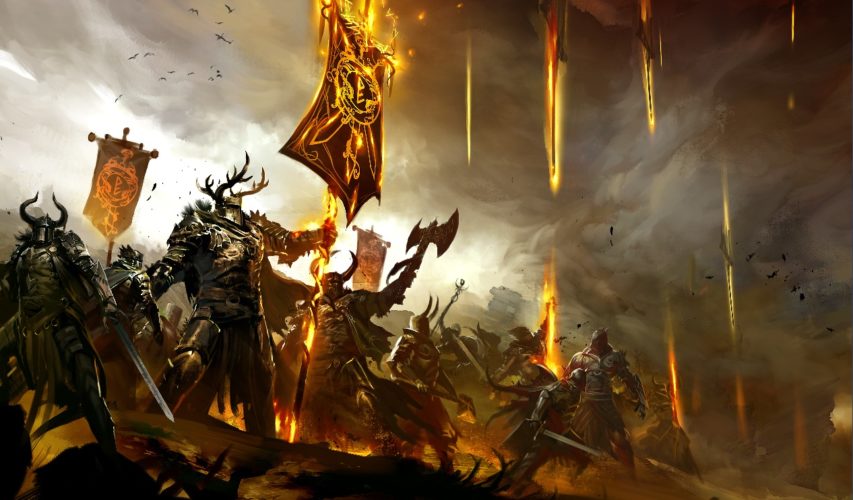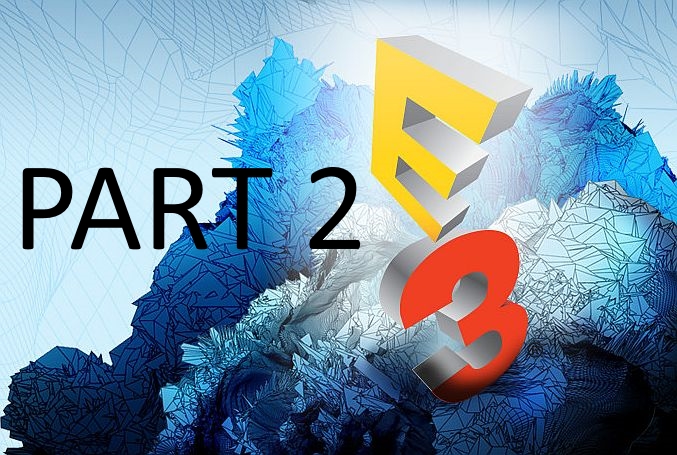Reviews & Previews
‘Shin Megami Tensei: Devil Summoner: Soul Hackers’ review

 Having recently completed the 3DS port of “Shin Megami Tensei: Devil Summoner: Soul Hackers“, I thought that I would share my thoughts on the game. I should note that I am a fan of Atlus and their “Shin Megami Tensei” games, so though I always try to remain objective, I may not always succeed.
Having recently completed the 3DS port of “Shin Megami Tensei: Devil Summoner: Soul Hackers“, I thought that I would share my thoughts on the game. I should note that I am a fan of Atlus and their “Shin Megami Tensei” games, so though I always try to remain objective, I may not always succeed.
The game places you in the role of a hacker (this hacker has no default name, but the novelization of the game calls him Keiji Minegishi) that is in a group called Spookies. The other members of this group include your childhood friend, Hitomi, who becomes possessed by a mysterious female devil named Nemissa. The way to tell who is in control of the body, Hitomi or Nemissa, is by looking at the hair; Nemissa will instantly cause the hair to turn silver.
Next up is the leader of your group, a man that goes by the name “Spooky”. He is only 25, but looks much older due to being a heavy smoker. He also has a rather strong inferiority complex.
Junnosuke Kitagawa, also known as Lunch, makes up the third member of the group. He specializes in hacking and modifying hardware, and tends to take on things one step at a time. Lunch has issues with his father.
The fourth member is Shingo Sako, or Six. He is a bit of a gun maniac, though he has little combat experience. Six is only 17 years old, making him the youngest member of the group, and carries a painful memory about his sister with him.
Yūichi Haga is the final member of your little hacker group. Yūichi grew up in a wealthy family, and, perhaps as a result, has a childlike nature. He is a year older than Six, but Six still treats him like a child. He is eager to prove himself to the group.
With the cast explained, we’ll move on to the story. You have managed to hack your way into the new MMORPG known as Paradigm X. It seems like a regular MMO… until you begin getting messages threatening to steal your very soul. Luckily, however, you are saved by a creature named Kinap, who takes the form of several animals. Kinap sends you on vision quests, where you live out the last moments of several souls, gaining new information. You end up utilizing this information to help your investigation into the mysteries occurring in the real world. As you solve these mysteries, you learn more and more about the company Algon Soft, which created the new MMORPG, Paradigm X. You also learn of a mysterious group called the Phantom Society. What do these two groups have to do with each other? Can you figure out the truth and stop the devious plans at work, or will you fall in your mission?
The gameplay itself is standard “Shin Megami Tensei” fare. You can speak to demons (though some demons won’t speak with you unless you have a certain chip installed in your comp) and attempt to get them to join you, or you can simply fight through. If you fight, you choose all of your party’s actions at once, then the game utilizes each person’s (and demon’s) agi attribute to decide who goes first. The battle system varies a bit from the normal “SMT” style, however, as each demon has its own personality type. This personality trait determines what actions will raise their loyalty and what actions they may refuse to do. For instance, Kind demons love to heal people, and will usually rebel (at least if their loyalty is not high enough) if you command them to injure something. Wild demons love to injure things physically, but detest magic. In addition, the personality determines what, if anything, demons may do in certain situations. If a Kind demon is loyal enough, for example, it may save you from a lethal hit, allowing you to fight on (if your main character dies, it’s game over).
The maps are rather straightforward in many cases (at least compared to earlier titles), so fans of the older games may not be happy with some of the maps.
The final thing to note, though perhaps it is one of the more interesting elements of the game, is the ability to modify your comp. It has 5 slots, which you can plug various chips into. These chips have a variety of functions, including allowing you to save anywhere in the game. You can also change the game’s difficulty at any time, which several have taken advantage of (while they were playing Hard mode). On the lower difficulty, most demons in the Compendium cost quite a bit less (exceptions are the Element and Mitama races).
Overall, I rather enjoyed the story and gameplay, especially when I would get defeated several times in a row (I tend to love difficult games, and this did not disappoint).
Final rating:
Reviews & Previews
Valorant Game Review: Gameplay, Monetization, and Safe Top-Up Tips

Introduction: Enter the World of Valorant
Riot Games’ Valorant has become one of the most influential tactical shooters in recent years, blending precise gunplay with hero-style abilities. Unlike traditional FPS titles, Valorant requires players not only to aim well but also to think strategically about agent abilities, team synergy, and map control.
As players explore the game, many are drawn to unlocking weapon skins, battle passes, and premium bundles that enhance the overall experience. These items require in-game currency, which can be acquired when you choose to buy Valorant points. For a secure and smooth transaction, I’ve found LootBar to be one of the most reliable platforms, offering fast service and peace of mind when topping up.
Core Gameplay and Mechanics
Valorant is built on competitive integrity and teamwork. Each match pits two teams of five against each other, with one side attacking and the other defending. The attackers plant the “Spike” (similar to a bomb), while the defenders aim to prevent detonation.
What makes Valorant stand out is its unique blend of classic FPS gunplay with hero-based abilities. Unlike pure shooters, where winning relies solely on aim, Valorant demands strategic use of smokes, flashes, heals, and other utility skills. This layered complexity ensures that no two matches feel the same.
For casual players, the game offers quick modes like Spike Rush and Deathmatch, making it easy to enjoy Valorant in short sessions. Hardcore players, meanwhile, can grind ranked matches, aiming to climb from Iron all the way to Radiant.
Agents and Customization
The roster of agents in Valorant is one of its biggest attractions. Each agent has unique abilities that can turn the tide of a match, from duelists designed to secure kills to controllers that manipulate the battlefield with smokes and walls.
Customization plays a huge role in keeping the game fresh. Skins for weapons are more than just cosmetic—they provide sound effects, finishers, and animations that add flair to your victories. While skins don’t alter gameplay balance, they are highly sought after in the community, becoming a way to show identity and prestige.
This is where Valorant Points (VP) come in. Skins, bundles, and event passes all require VP, making them the primary currency for players who want to personalize their gameplay.
Valorant’s Payment System and Monetization
Overview of In-Game Purchases
Valorant uses two main currencies:
· Valorant Points (VP): Purchased with real money and used for skins, bundles, and event passes.
· Radianite Points (RP): Primarily used to upgrade weapon skins, often acquired alongside VP.
Players frequently invest VP to unlock exclusive cosmetics, such as seasonal collections, limited bundles, or battle passes. These time-sensitive offers often create a sense of urgency, encouraging players to recharge quickly so they don’t miss out.
Pay-to-Win Considerations
One of the strongest aspects of Valorant’s system is that it avoids being “pay-to-win.” Spending money does not grant raw gameplay advantages—accuracy, reflexes, and teamwork still determine victory. Instead, purchases enhance the game’s aesthetic and social experience.
That said, investing in skins can save time compared to grinding for smaller rewards, and it allows players to participate fully in seasonal events without limitations.
Safe, Fast, and Reliable Top-Up Solutions
When it comes to topping up, safety and speed are critical. Players don’t want to risk their accounts or experience delays. That’s why many turn to platforms like LootBar, which emphasize secure transactions, fast delivery, and a smooth user interface.
LootBar stands out with strong trust metrics and a reputation among gamers for reliability. Using it ensures you can focus on playing Valorant, rather than worrying about whether your points will arrive on time.
Community, Social Features, and Competitive Scene
Valorant thrives not only as a game but also as a global esports phenomenon. It’s ranked ladder fuels competition, while international tournaments like the VCT (Valorant Champions Tour) attract massive audiences.
For casual players, the game’s social features make it easy to connect with friends, form squads, and join communities. Limited-time events and seasonal missions encourage teamwork and participation, keeping the community active year-round.
This dual approach – serving both casual and competitive players—is one of Valorant’s greatest strengths.
Pros and Cons of Valorant
Pros
· Tight, strategic gameplay with high skill expression
· Wide roster of agents with unique playstyles
· Regular updates and seasonal events keep the game fresh
· Strong esports ecosystem and global recognition
Cons
· Steep learning curve for beginners
· Skins and bundles can be costly
· Free players may face long grinds to maximize progress
While these drawbacks exist, they are softened by the fact that the core gameplay remains free-to-play and fair. Occasional VP purchases can help smooth the journey without undermining balance.
Tips for New Players
For those just starting out, it’s wise to:
· Begin with easier agents like Phoenix or Sage to learn core mechanics.
· Play unranked modes before diving into competitive matches.
· Save Valorant Points for bundles or battle passes, which offer more value.
A small VP purchase early on can also give new players access to skins that make the experience more enjoyable, without being overwhelming.
Conclusion: Is Valorant Worth Playing?
Valorant has cemented its place as one of the best tactical shooters available today. It combines strategic depth, fast-paced gunplay, and a thriving community, making it appealing to both casual and competitive players.
For those looking to personalize their journey, unlocking skins and bundles is part of the fun. The safest and most convenient way to do so is to buy Valorant points through LootBar. With a trusted platform handling the transaction, players can focus on what matters most—outsmarting opponents and enjoying every match.
Features
Exploring Valorant eSports Stats: Unveiling the Metrics Behind Competitive Excellence

In the rapidly expanding realm of Valorant eSports, statistical analysis plays a pivotal role in understanding player performance, team dynamics, and the strategic nuances that define success in competitive play. This article delves into the significance of Valorant eSports stats, their impact on the competitive landscape, and how they empower players, teams, and fans alike.
Key Metrics in Valorant eSports Stats
Valorant eSports stats encompass a wide array of metrics that provide insights into player proficiency and team strategies. These include individual performance indicators such as kill-death ratios (K/D), average damage per round (ADR), headshot percentages, and assist counts. Team statistics such as round win percentages, first blood percentages, and economy management efficiency further illuminate strategic strengths and areas for improvement.
Analyzing Player Performance and Contribution
For professional Valorant players, statistics serve as a critical tool for evaluating individual performance and contribution to team success. By analyzing metrics like K/D ratios and ADR, players can assess their impact in securing eliminations, dealing damage, and supporting team objectives. This data-driven approach enables players to identify strengths to leverage and weaknesses to address, enhancing their overall effectiveness in competitive matches.
Strategic Insights and Adaptation
Valorant eSports stats provide valuable strategic insights that shape team tactics and gameplay adaptations. Coaches and analysts analyze statistical trends to optimize agent selections, refine map strategies, and counter opponents’ playstyles effectively. The ability to leverage data-driven decision-making empowers teams to evolve their tactics, adapt to meta-game shifts, and maintain a competitive edge in the dynamic world of Valorant eSports.
Tracking Tournament Trends and Meta-Game Evolution
Beyond individual matches, Valorant eSports stats track broader tournament trends and meta-game evolution. Historical data on agent pick rates, map preferences, and round outcomes reveal emerging strategies and meta-shifts over time. This analytical depth allows teams and analysts to anticipate trends, innovate strategies, and stay ahead of competitors in high-stakes tournaments and league play.
Fan Engagement and Spectator Experience
Valorant eSports stats enrich the spectator experience during live broadcasts and tournament coverage. Fans can follow real-time updates on player performances, compare stats across matches, and engage in discussions about standout plays and strategic decisions. Interactive platforms and statistical dashboards enhance viewer engagement, fostering a deeper connection with the competitive narratives unfolding in Valorant eSports.
Impact on eSports Betting and Fantasy Leagues
Valorant eSports stats play a crucial role in eSports betting markets and fantasy leagues, where informed decision-making hinges on statistical insights. Bettors and fantasy league participants leverage player and team stats to assess form, predict match outcomes, and manage their investments strategically. Real-time updates and comprehensive data analysis enhance the strategic depth and excitement of eSports engagement for fans worldwide.
Technological Advancements and Data Visualization
Advancements in technology have revolutionized how Valorant eSports stats are accessed and analyzed. Streaming platforms and eSports websites offer sophisticated data visualization tools, interactive heatmaps, and player performance overlays that enhance the depth and accessibility of statistical analysis. These technological innovations provide analysts, commentators, and fans with enhanced insights into gameplay dynamics and strategic decision-making.
Future Innovations in Statistic Analysis
As Valorant continues to evolve as an eSports powerhouse, the future of statistical analysis promises further innovations. AI-driven predictive analytics, enhanced machine learning algorithms, and real-time performance tracking technologies are poised to revolutionize how eSports stats are processed and utilized. These advancements will elevate the precision, depth, and predictive capabilities of statistical analysis in Valorant eSports, shaping the future of competitive gaming.
Casual
Encouraging Growth and Motivation: Resources for Child Development

Child development is a complex journey marked by critical milestones where each stride forward builds upon the foundation of the previous one. Acknowledging children’s individual needs, pediatric therapy services tailor strategies to foster physical, emotional, and cognitive growth. To support this transformative process, environments that prompt curiosity and engagement, coupled with advanced educational tools, play an instrumental role in shaping young minds. These resources, carefully selected and applied, can significantly amplify a child’s developmental trajectory. Keep reading to learn about the effective ways these tools and techniques can aid in advancing childhood milestones.
Pediatric Therapy Services: Enhancing Developmental Milestones
Pediatric therapy services support children as they reach and surpass developmental milestones. These services, often provided by skilled therapists, address various growth challenges, ensuring each child has the best possible start in life. From speech and occupational therapy to physical and behavioral interventions, these professionals tailor their approach to meet the unique needs of every young patient.
Therapists work relentlessly to motivate children, fostering an environment where milestones are not merely achieved but celebrated. Through personalized, one-on-one sessions, children gain the confidence and skills necessary to navigate their developmental journeys more easily. The trust between therapist and child is a solid foundation for consistent progress and paves the path for lifelong learning and adaptation.
Resource provision is a key component of pediatric therapy, equipping parents with the tools to continue therapy practices at home. Effective communication between therapists and families ensures a cohesive strategy that envelops the child’s daily routine, enhancing the therapy’s impact. It also allows parents to identify subtle progress, reinforcing their pivotal role in the child’s developmental success.
If you’re looking for pediatric therapy in your area, a simple Google search like “pediatric therapy Arizona” will help you find local providers and services tailored to your child’s needs, ensuring they receive the specialized care necessary for their development.
Optimizing Play Spaces: Creating Environments for Learning and Exploration
Optimized play spaces are vital platforms where children engage with their world, build skills, and unleash their creativity. Designers of such areas pay astute attention to elements that promote safe exploration and intellectual stimulation. A thoughtfully arranged play environment serves as a place of entertainment and a crucible for burgeoning development.
Professionals incorporate a variety of tactile and visual stimuli within play areas to cater to diverse developmental needs and interests. Stimulating sensory experiences is central to cognitive and motor skill refinement among younger populations. The intentional selection of colors, textures, and interactive features sparks curiosity and encourages physical activity, which is fundamental to healthy growth.
Accessibility remains paramount in creating play spaces, ensuring they cater to children across all abilities. Including adaptive resources within these environments demonstrates a commitment to inclusive development, allowing every child to participate and benefit from the joy and learning play offers. Such inclusiveness fosters a sense of community and belonging, which is essential for emotional and social development.
Affording children autonomy in their play advances self-directed learning and problem-solving capabilities. When children feel empowered to make choices within their play, they better understand their preferences and abilities, setting the stage for confidence and self-awareness — qualities that are instrumental as children grow and transition through life’s stages.
Additionally, incorporating elements like fake plants or outdoor plants from retailers like Nearly Natural outdoor plants into play spaces can enhance children’s sensory and aesthetic experience.
Interactive Learning Tools: Technology and Resources for Cognitive Development
Interactive learning tools harness technology’s power to solidify children’s cognitive development. These digital resources provide an array of engaging, educational content that aligns with critical thinking and problem-solving skills.
Software and applications designed for children’s learning capitalize on the allure of multimedia to capture young minds. Effective education solutions provide children with stimulating challenges that are age-appropriate and aligned with developmental targets.
The discerning use of educational technology in classrooms and homes can reinforce concepts and skills taught through traditional methods. It creates a harmonious blend of instruction and interactive play, thereby cementing a child’s understanding and retention of information.
Providers of such educational platforms are ever vigilant, updating content to reflect new educational strategies and the latest academic research. Thus, children equipped with these technological tools remain at the vanguard of current learning methodologies, all while engrossed in fun and dynamic ways.
Overall, caregivers and educators can provide comprehensive support for children’s developmental journeys by integrating pediatric therapy services, optimized play spaces, and interactive learning tools. These resources nurture their physical, emotional, and cognitive growth and cultivate a lifelong love for learning and exploration.
-

 Guides6 years ago
Guides6 years ago6 Proven Ways to Get more Instagram Likes on your Business Account
-
Mainstream11 years ago
BioWare: Mass Effect 4 to Benefit From Dropping Last-Gen, Will Not Share Template With Dragon Age: Inquisition
-

 Mainstream7 years ago
Mainstream7 years agoHow to Buy Property & Safe Houses in GTA 5 (Grand Theft Auto 5)
-

 Guides1 year ago
Guides1 year agoFree Fire vs PUBG: Comparing Graphics, Gameplay, and More
-

 Casual2 years ago
Casual2 years ago8 Ways to Fix Over-Extrusion and Under-Extrusion in 3D Printing
-

 Mainstream13 years ago
Mainstream13 years agoGuild Wars 2: The eSports Dream and the sPvP Tragedy
-

 Other2 years ago
Other2 years agoAjjubhai UID: Free Fire Details & Earnings
-

 Gaming News2 years ago
Gaming News2 years agoSwiping, Tapping, and Tilting: How Mobile Games Are Played Today






